Icy gold: Pakistan’s biggest wealth is melting
Pakistan’s glaciers are melting fast; experts urge swift action with innovative solutions before it’s too late
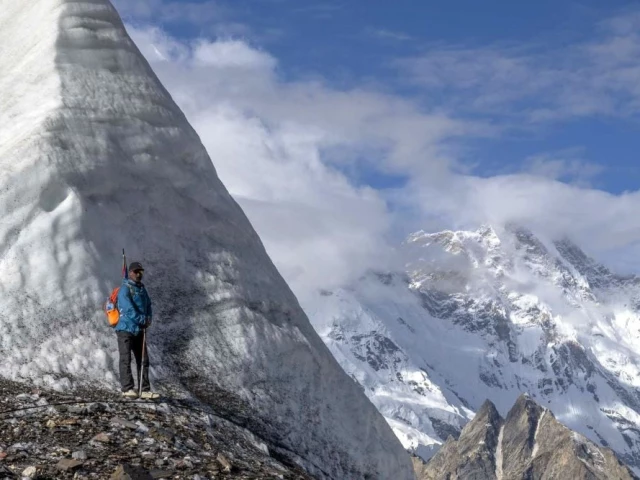
Have you ever contemplated Pakistan's potential to emerge as a "Climate Hero" from the global climate crisis? This is not a fanciful notion; it is an attainable objective that could not only elevate Pakistan's standing as a responsible frontline state against the onslaught of global warming but also unlock access to billions in green financing.
A decade ago, such an idea might have been dismissed as mere "building castles in the air," but in 2025, with technology evolving at a rapid pace and scientists nearing miraculous breakthroughs, this vision is becoming increasingly plausible.
Right now, I am talking about the overhead natural water tanks of Pakistan, called glaciers.
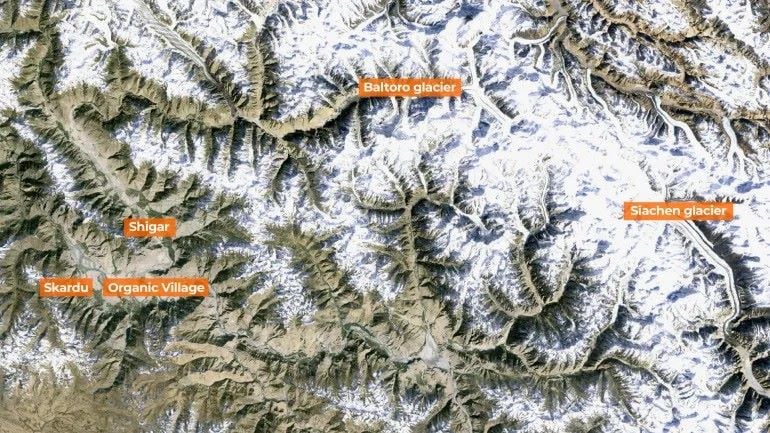
The position of the Baltoro and Sachien glaciers in Pakistan. PHOTO: AJ Labs
Let us protect our glacial masses from melting! There are innovative methods and technologies which can slowdown rapid pace of glacial melting. According to Dr. Amina Khan, a glaciologist, "the ice won’t wait for perfect solutions," and Pakistan must act now with both wisdom and daring.
Deep in the north, where majestic peaks touch the sky, this silent crisis is unfolding. Pakistan, home to the largest number of glaciers outside the polar regions, is witnessing a dramatic and deadly melt.
More than 7,000 glaciers that feed our rivers and fill our dams are now shrinking at an alarming pace. Each year, we’re losing nearly 1.5% of our glacial mass — enough to fill the Tarbela Dam three times over!
And it’s not just about water disappearing. There are over 3,000 unstable glacial lakes quietly building pressure, threatening to burst at any moment and unleash catastrophic floods down the valleys. These glacial lake outburst floods — or GLOFs — can wash away entire communities in a matter of hours.
We have seen GLOFS events recently in Pakistan as mighty Shisper glacier burst damages homes and villages in Gilgit Baltistan area last month.
But while the ice melts, so does time. Scientists warn that if current trends continue, many of Pakistan’s glaciers could vanish by 2050. This would spell disaster for food security, hydropower, agriculture, and the lives of millions who depend on the mighty Indus and its tributaries.
High in the mountains of Pakistan, an invisible emergency is unfolding. Our glaciers — over 7,000 of them — are melting at a pace never seen before. And of course, there are undeniable scientific evidences available.
- International Centre for Integrated Mountain Development (ICIMOD) Report (2023): Pakistan’s glaciers (part of the Hindu Kush Himalaya, HKH) are losing mass 30–50% faster than in the 1990s.
- NASA Studies (2022–2024): Satellites show glaciers like Siachen, Baltoro, and Biafo retreating 10–40 meters annually, up from 5–15 meters/year in the 2000s.
- Pakistan Meteorological Department (PMD): Recorded 3,044 glacial lakes in 2023 (up from 2,420 in 2018), with 33 deemed at high risk of Glacial Lake Outburst Floods (GLOFs).
Obviously following key drivers are cause of rapid melt
A. Rising Temperatures
- World Bank (2023): Pakistan’s annual temperature rose 1.3°C since 1960, double the global average.
- Heatwaves (2022–2024): Record-breaking temperatures (e.g., 53°C in Jacobabad) accelerate summer melt.
B. Black Carbon (Soot) Deposition
- UNDP Study (2024): Soot from burning fossil fuels, crop residue, and brick kilns darkens glacier surfaces, absorbing heat and increasing melt rates by 20–30% (notably in the Karakoram and Himalayas).
C. Erratic Snowfall
- IUCN (2023): Reduced winter snowfall fails to replenish glaciers, despite occasional "surge cycles" in the Karakoram.
Impacts
- Water Security: Short-term flood risks (GLOFs) followed by long-term river depletion (Indus could lose 40% flow by 2100, per Nature Sustainability, 2023).
- Disasters: 2022 Pakistan Floods (linked to glacial melt) displaced 33 million people and caused $30B in damages.
- Biodiversity Loss: Alpine ecosystems (e.g., snow leopards, Himalayan ibex) face habitat fragmentation.
Scientific Consensus
Hindu Kush Himalaya (HKH) Assessment (ICIMOD, 2023): Predicts 80% glacier volume loss in Pakistan by 2100 under current emissions.
"Pakistan’s glaciers are now in a state of irreversible decline. Even if warming stops today, melt will continue for decades due to current ice loss momentum." Glaciologist Dr. Amina Khan (Quaid-i-Azam University, 2024)
These frozen giant water towers feed our rivers, recharge our aquifers, and support the livelihoods of over 220 million people. But year after year, as temperatures rise, they shrink and retreat. If we don’t act now, many of them could disappear by 2050 — a nightmare scenario for a country so dependent on snowmelt.
We need to develop a national consensus and strategy to declare a war against this environmental catastrophe. Developing a policy, a strategy and a “Glaciers Protection Act” would be commendable in shortest possible time, but action in the field is what we should go all out.
To make all this happen, Pakistan must launch a National Glacier Rescue Mission. This should include installing advanced monitoring networks, piloting glacier covering technology, draining dangerous lakes, and establishing a powerful Glacier Protection Authority. A National Ice Fund could attract support from climate finance mechanisms like the Green Climate Fund.
Let’s see how world and communities are doing to protect glaciers;
But not all hope is lost. Around the world, scientists and engineers are experimenting with bold and often fascinating ways to slow the melt and even protect these natural treasures.
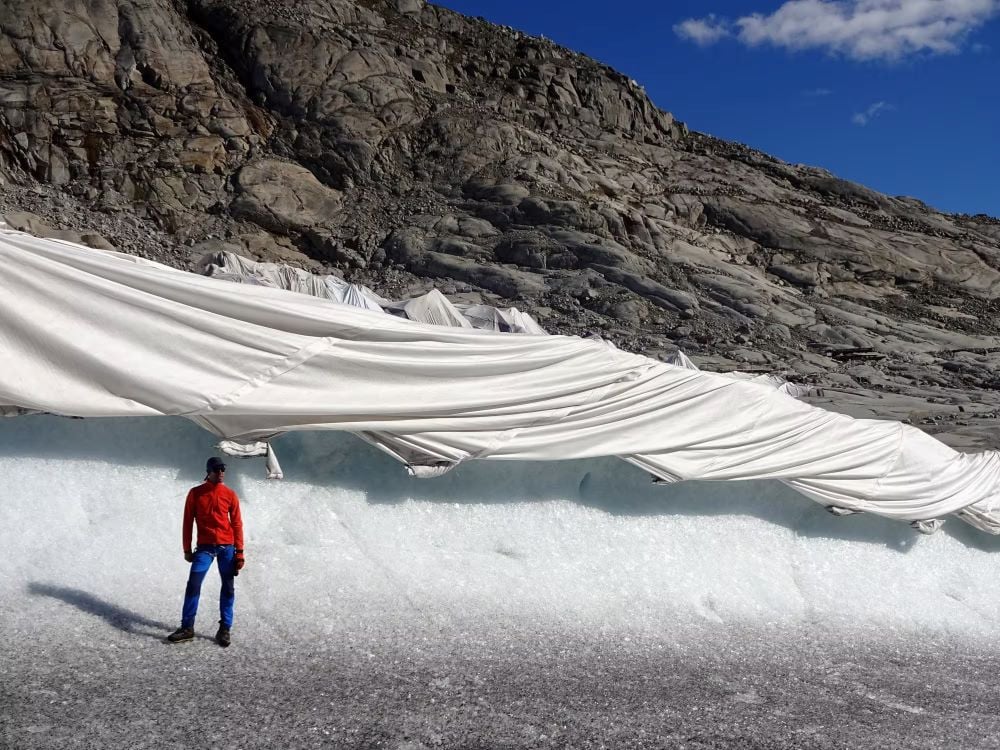
A researcher stands in front of the Rhone Glacier covered in geotextiles that protect it from accelerated melting. Source: Matthias Huss/ University of Dundee
White Blanket Covers (Geotextile Wrapping)
In the Alps, particularly Switzerland and Austria, scientists are literally wrapping glaciers in huge white blankets made of geotextile fabric. These reflective covers act like sunshades, bouncing sunlight away and reducing surface melting by up to 70% during summer. Pakistan could pilot this approach on select high-risk glaciers, especially near glacial lakes prone to sudden outburst floods.
Artificial Snowmaking
Snow, even when manmade, has a higher reflectivity than exposed ice or rock. Using snow guns — the kind used in ski resorts — scientists can produce artificial snow to cover glacier surfaces. In places like Norway and Colorado, this technique is being used to rebuild shrinking snowpacks. While energy-intensive, it could be viable in targeted locations during peak melt seasons.
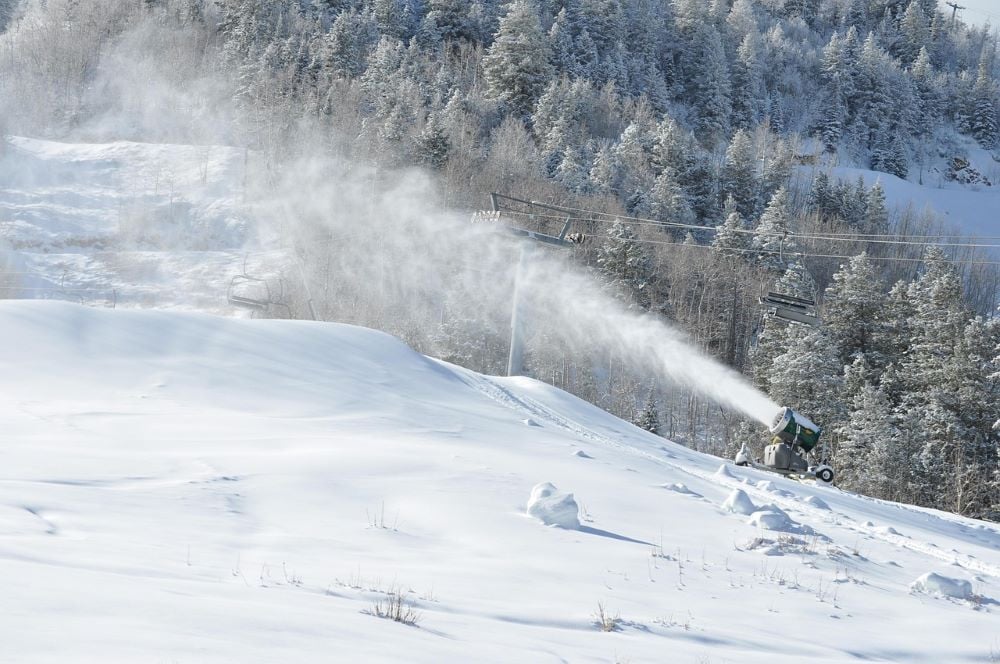
Snow making machine. PHOTO: PIXABAY
Silica Microspheres and Reflective Sprays
Researchers at Arizona State University have developed “glacier sunscreen” — tiny, biodegradable silica microspheres that can be sprayed over glacier surfaces. These beads create a reflective layer that significantly slows melting. Though still in experimental phases, they could be adapted for Pakistan’s rapidly melting glaciers.
Ice Stupas (Artificial Ice Reservoirs)
In Ladakh, Indian engineer Sonam Wangchuk developed a breathtaking innovation — the ice stupa. These cone-shaped artificial glaciers are created by piping water downhill during winter nights, allowing it to freeze into a towering structure. As temperatures rise in spring, the stupa melts gradually, providing water during critical farming months. Pakistan’s mountain valleys could greatly benefit from building such water towers in winter.
Subsurface Drainage of Glacial Lakes
One of the biggest threats from melting glaciers is the formation of unstable glacial lakes. To prevent sudden floods, engineers are using siphoning pipes and controlled drainage channels to lower lake levels. This method is already being used in Gilgit-Baltistan under the GLOF II project, but it needs to be expanded to cover hundreds of high-risk lakes.
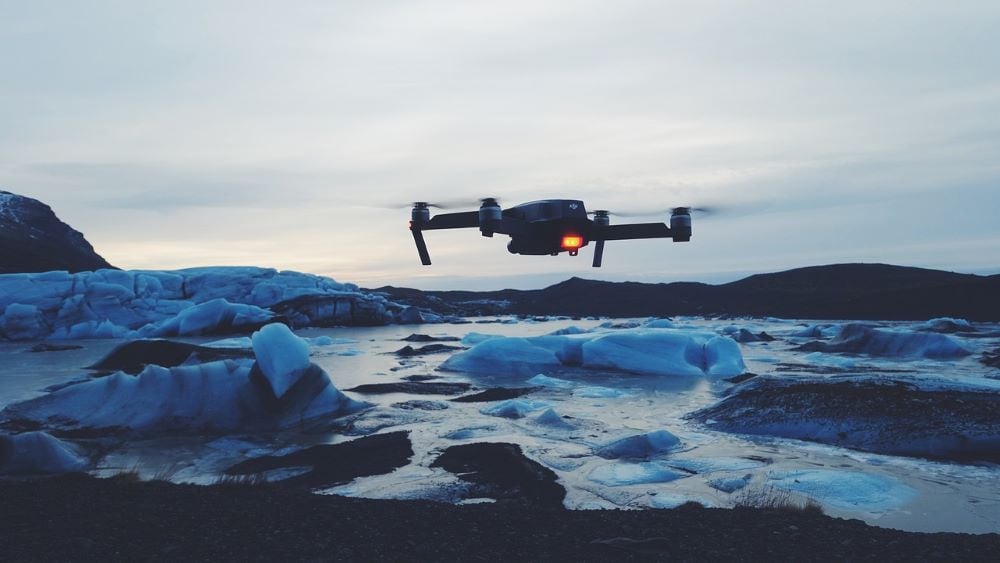
A monitoring drone at the cryosphere. PHOTO: PIXABAY
Drones and Satellite Monitoring
Cutting-edge satellite imagery and drones are now used globally to track glacier mass balance, detect new lake formation, and forecast melt trends. Pakistan’s capacity for remote sensing must be expanded. Real-time data from drones, combined with satellite feeds, can help create precise early warnings and direct intervention strategies.
Early Warning Systems (EWS)
Currently, Pakistan has only 16 functioning flood early warning stations. To truly protect vulnerable communities, we need to scale this up to 200 or more, covering all glaciated valleys. These systems must be equipped with sensors, SMS-based alert networks, and local response teams trained in evacuation and rescue.
Glacier Legal Protection
While technologies can help, the foundation of glacier conservation lies in law. Countries like Bhutan and Switzerland have declared glaciers as protected entities, with strict no-go zones for mining, logging, and construction. Pakistan needs a Glacier Protection Act to legally recognize glaciers as national assets and regulate all harmful activities in their surroundings.
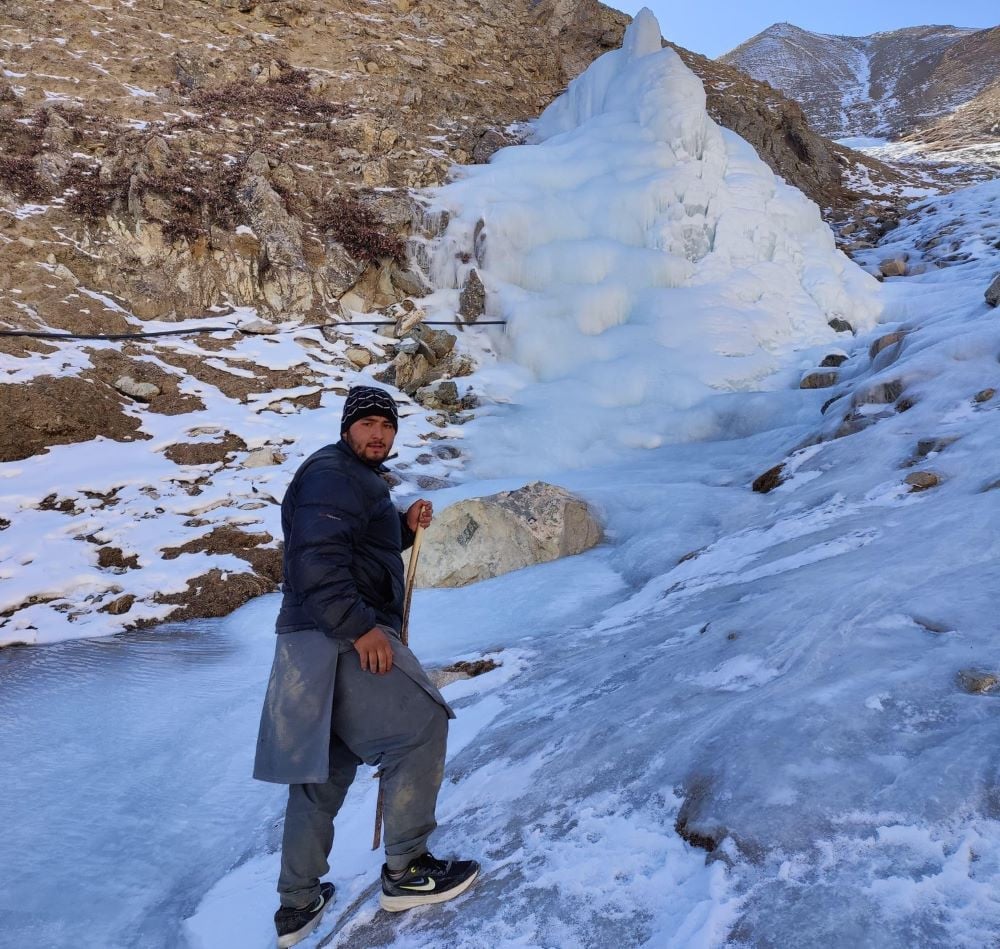
A volunteer from Ghanche district of Gilgit-Baltistan working to revive an artificial glacier. PHOTO: UNICEF PAKISTAN
Community-Based Glacier Stewardship
Traditional glacier guardianship, once practiced by indigenous Balti and Wakhi tribes, must be revived and integrated into national strategies. Locals possess knowledge about snow patterns, crevasse dangers, and signs of impending ice shifts. Training and supporting these communities as stewards of their own landscapes will ensure long-term protection.
Glacier Tourism for Conservation
Eco-tourism can be a powerful ally in saving our glaciers. Countries like Switzerland generate millions in revenue from glacier trekking, ice caves, and education tours. If managed carefully, glacier tourism in Pakistan could raise awareness, create jobs, and fund conservation projects — while ensuring these landscapes are valued and preserved.
Believe me we can do a lot after developing a policy and a Glaciers Protection Act.
To bring all efforts under one roof, Pakistan must establish a dedicated Glacier Protection Authority. This body would coordinate scientific research, enforcement of protective laws, funding mechanisms, and public outreach. A National Glacier Fund, linked with global climate finance platforms like the Green Climate Fund, can provide long-term support for glacier-saving projects.
The situation is dire, but not hopeless. The world is experimenting with bold ideas. Pakistan must not lag behind. Our glaciers are more than frozen water — they are life, security, and sovereignty. If we act wisely and swiftly, we can still turn the tide and save our ice giants from extinction.
The writer is an environmentalist, freelance environment and climate consultant and a climate analyst and commentator.



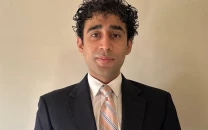



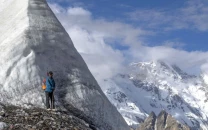

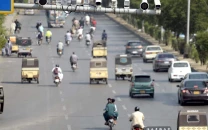
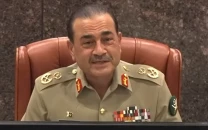
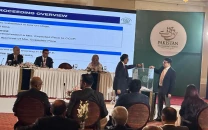

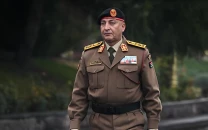






COMMENTS
Comments are moderated and generally will be posted if they are on-topic and not abusive.
For more information, please see our Comments FAQ